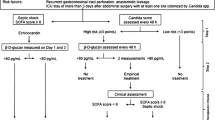Abstract
The first-line treatment for intra-abdominal abscess is source control. Sometimes, however, source control is too invasive for relatively small abscesses and is not feasible due to the risk of injury to some organs. Based on reports that fosfomycin (FOM) can break up biofilms to enhance the permeability of other antibiotics, we investigated the FOM time-lag combination therapy (FOM-TLCT). We enrolled 114 patients who had intra-abdominal abscess after gastrointestinal surgery and examined the efficacy of FOM-TLCT using the same therapeutic antibiotic (TA) as that which had been used previously, but had proven ineffective, at the same dose schedule. The efficacy endpoint determination was carried out as follows: among the systemic inflammatory response syndrome (SIRS)-positive cases, even after administration of TA, excellent outcome was defined as SIRS negative within 7 days of FOM-TLCT with TA without the need for other treatment, including other antibiotics or drainage. Of the 114 patients enrolled, 104 cases (SIRS positive 73; SIRS negative 31) were assessed. Ten patients were excluded; four had received TA at higher doses, three had received different TAs, and three were considered to have bacteria resistant to TAs. Among these patients, 86.3% (63/73) of the SIRS-positive cases were classified as excellent, and 90.3% (28/31) of the SIRS-negative cases were classified as effective. In total, the efficacy rate was 87.5% (91/104). The total no-response rates were 12.5% (13/104). FOM-TLCT seems to be effective for treating refractory intra-abdominal abscess.




Similar content being viewed by others
References
Kumon H, Ono N, Iida M, Nickel JC. Combination effect of fosfomycin and ofloxacin against Pseudomonas aeruginosa growing in a biofilm. Antimicrob Agents Chemother. 1995;39:1038–44.
Finlayson EV, Goodney PP, Birkmeyer JD. Hospital volume and operative mortality in cancer surgery: a national study. Arch Surg. 2003;138:721–5.
Kodera Y, Sasako M, Yamamoto S, Sano T, Nashimoto A, Kurita A, Gastric Cancer Surgery Study Group of Japan Clinical Oncology Group. Identification of risk factors for the development of complications following extended and superextended lymphadenectomies for gastric cancer. Br J Surg. 2005;92:1103–9.
Yamamoto S, Fujita S, Akasu T, Moriya Y. A comparison of the complication rates between laparoscopic colectomy and laparoscopic low anterior resection. Surg Endosc. 2004;18:1447–51.
Dellinger RP, Levy MM, Carlet JM, Bion J, Parker MM, Jaeschke R, et al. Surviving sepsis campaign: international guidelines for management of severe sepsis and septic shock: 2008. Crit Care Med. 2008;36:296–327.
Costerton JW, Lam J, Lam K, Chan R. The role of the microcolony in the pathogenesis of Pseudomonas aeruginosa. Rev Infect Dis. 1983;5:S867–73.
Gordon CA, Hodges NA, Marriott C. Antibiotic interaction and diffusion through alginate and exopolysaccharide of cystic fibrosis-derived Pseudomonas aeruginosa. J Antimicrob Chemother. 1988;22:667–74.
Hoyle BD, Costerton JW. Bacterial resistance to antibiotics: the role of biofilms. Prog Drug Res. 1991;37:91–105.
Mikuniya T, Kato Y, Ida T, Maebashi K, Monden K, Kariyama R, et al. Treatment of Pseudomonas aeruginosa biofilms with a combination of fluoroquinolones and fosfomycin in a rat urinary tract infection model. J Infect Chemother. 2007;13:285–90.
Gristina AG. Biomedical-centered infection: microbial adhesion versus tissue integration. Science. 1987;237:1588–95.
Koch C, Høiby N. Pathogenesis of cystic fibrosis. Lancet. 1993;341:1065–9.
Kusachi S, Sumiyama Y, Nagao J, Kawai K, Arima Y, Yoshida Y, et al. New methods of control against postoperative methicillin-resistant Staphylococcus aureus infection. Surg Today. 1999;29:724–9.
Kusachi S, Nagao J, Saida Y, Watanabe M, Nakamura Y, Asai K, et al. Twenty years of countermeasures against postoperative MRSA infection. Surg Today. 2010 (in press).
Acknowledgments
We express our sincere gratitude to Dr. Izumi Hayashi, who devised this method of treatment and provided us with a great deal of advice in regard to this study.
Author information
Authors and Affiliations
Corresponding author
About this article
Cite this article
Kusachi, S., Nagao, J., Saida, Y. et al. Antibiotic time-lag combination therapy with fosfomycin for postoperative intra-abdominal abscesses. J Infect Chemother 17, 91–96 (2011). https://doi.org/10.1007/s10156-010-0167-0
Received:
Accepted:
Published:
Issue Date:
DOI: https://doi.org/10.1007/s10156-010-0167-0




